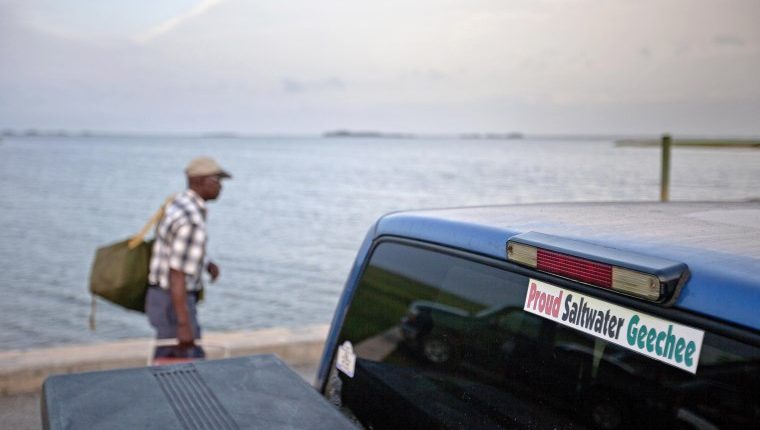The eradication of these neighborhoods can be traced back to their creation when white supremacists terrorized Black people, destroying whole blocks of homes and businesses or driving them out of town, as seen with the Tulsa Race Massacre in 1921 and the Rosewood, Florida, massacre in 1923.
But in more recent times, the dwindling of Black strongholds is due in part to the culmination of amended ordinances, uneven tax rates, home devaluations, and political challenges that leave communities vulnerable to developers and rampant gentrification.
“Something as simple as, they change or they rezone areas,” said Elizabeth Clark-Lewis, the director of the public history program at Howard University. “People with political power can make determinations that will ring the death bell for these towns.”
“We’ve seen gated areas, golf courses and planned unit developments directly linked to increasing the taxes and displacement of native Gullah-Geechees throughout the coast,” said Marquetta Goodwine, known as Queen Quet, the leader of the Gullah-Geechee nation.
On St. Helena Island in South Carolina, massive banners dot driveways and sidewalks reading “Protect the culture, protect the history, protect the land.”
The governing Beaufort County council blocked a golf course on Gullah-Geechee land after the developer, Elvio Tropeano, requested to remove the 503-acre (204-hectare) plot from a zoning district on the island. The zoning district bans gated communities and resorts in locations considered culturally significant. Tropeano has since filed two legal actions against the county to appeal the decision, and has since considered building homes on the property.
A local group, Community Coalition Action Network, supports the plan to build a golf course on the unoccupied land. Co-founder Tade’ Oyeilumi said she was originally against it; then she went to a listening session.
“When I heard Mr. Tropeano speak about the development and what he wanted to do with the development, the purpose of the development and how that was going to contribute to the community that we live in, I was blown away,” Oyeilumi said.
She fears the housing plan that the developer is now considering will instead have jarring results.
“It’s going to change the infrastructure to our community. It’s going to bring in that gentrification factor that people are saying they don’t want, faster. The golf course, on the other hand, minimizes that,” Oyeilumi said.

Residents of Hogg Hummock, a tiny Gullah-Geechee community on Sapelo Island in Georgia, filed a lawsuit in October to halt a zoning law they say will raise taxes, forcing them to sell their homes. McIntosh County commissioners voted in September to double the size of houses allowed in the community, also known as Hog Hammock — a move locals believe will draw in wealthy outsiders who want to build vacation getaways. Only a few dozen Black residents still live in the enclave of modest homes along dirt roads.
“My ancestors were forced to work on that land, and then they fought for the right to have that land,” said 23-year-old Keara Skates, a descendant who spent her last birthday speaking against the zoning law alongside state legislators in Atlanta, the state capital. “Sapelo Island has historically never seen the level of growth that’s being proposed. Where does that leave the descendants?”
McIntosh County Commission Chairman David Stevens said the community’s landscape is changing because some native owners have sold their property.
“I don’t need anybody to lecture me on the culture of Sapelo Island,” Stevens said, adding: “If you don’t want these outsiders, if you don’t want these new homes being built … don’t sell your land.”
Research by Brookings Institution fellow Andre Perry finds that homes in majority Black neighborhoods are appraised at significantly lower values than homes in neighborhoods where Black people are the minority. Perry says that developers can buy these homes at lower costs and sell them for a much higher price.
“A lot of people will call that a major tool of gentrification,” said Perry. “The people who live in those areas may be priced out ultimately, and then the companies or individuals who purchase those properties get profit as a result.”
Attorney Rukaiyah Adams runs a nonprofit called “Rebuild Albina” based in Portland, Oregon. The organization aims to educate, invest and restore homeownership to Black people in an area that used to be a thriving Black neighborhood.
“We cannot continue to extract and exploit to the breaking point,” said Adams. “We’re trying to create a new model for what that might look like, how we might live together.”
In Florida, one of the first incorporated self-governing Black municipalities in the U.S. was Eatonville, established in 1887. Located just 24 miles (39 kilometers) north of Disney World, the key challenge for present-day residents is the Orange County Public School Board, which owns 100 acres (40 hectares) of property in the middle of town.
Source: | This article originally belongs to Nbcnews.com










